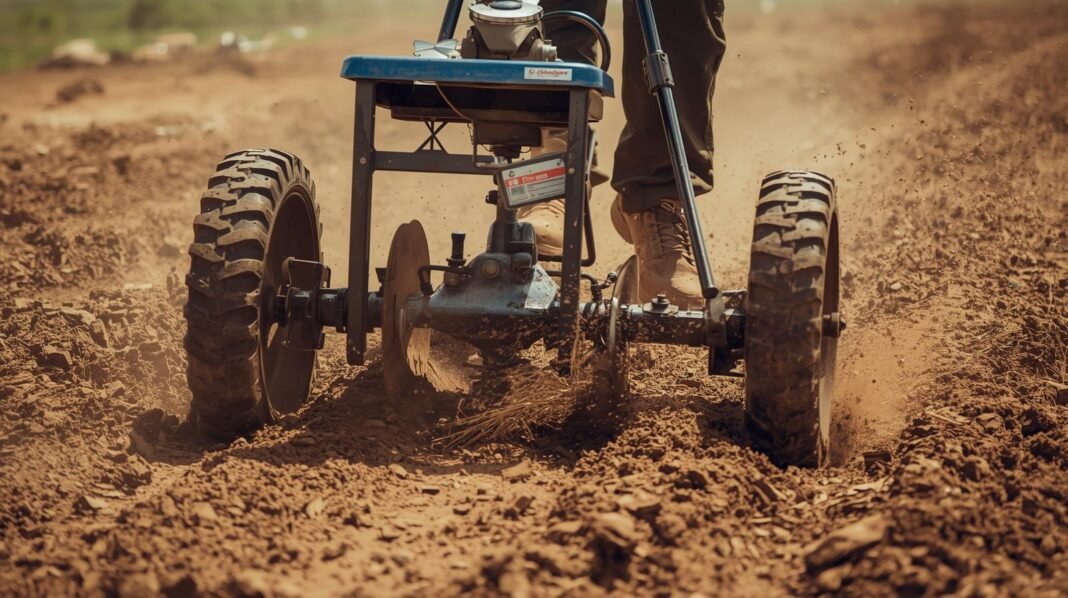At this year’s Nairobi International Trade Fair, visitors at the Agricultural Society of Kenya (ASK) showground were drawn to one machine that stood out from the big, shiny tractors on display — a compact, two-wheeled walking tractor.
Designed for smallholder farmers, this modest machine represents a growing shift in Kenya’s agricultural sector toward accessible, affordable mechanization.
A New Face of Farm Mechanization
For decades, mechanization in Kenya has been synonymous with large tractors and heavy machinery, often out of reach for small-scale farmers who make up more than 70% of the country’s agricultural producers.
The walking tractor — sometimes called a power tiller — changes that narrative. Compact, diesel-powered, and surprisingly powerful, this machine can plough up to three acres per day, transforming how small farms operate.
Unlike traditional tractors that require larger plots and trained operators, the walking tractor is simple to use, fuel-efficient, and adaptable to small or fragmented plots.
It fills a critical gap between manual labor and expensive mechanized solutions, helping farmers save time, reduce labor costs, and improve productivity.
Unveiled at the Nairobi Showground
The walking tractor unveiled at the Nairobi Showground this year drew attention not just for its performance but also for its price.
With a 13–16 horsepower diesel engine, the machine can plough, harrow, pump water, or even transport farm produce when fitted with a small trailer.
Its retail price of around KSh 450,000 makes it a far more affordable option than a conventional tractor.
To make ownership even easier, suppliers introduced flexible payment plans — including 30% down payment and up to one year of interest-free installments.
This approach aligns with national efforts to promote youth participation in mechanized agriculture, offering a realistic entry point for young agripreneurs and cooperatives.
Imported, Assembled, or Kenyan-Made?
While many visitors assumed the walking tractor was fully Kenyan-made, most of these machines are imported or locally assembled.
Some of the engines and parts come from Thailand and China, where walking tractors have been in use for decades.
Kenya has, however, taken steps to strengthen its role in local assembly and adaptation.
For instance, a Kenya–Thailand partnership supports local technicians in learning to assemble and maintain small-scale farm machinery, including walking tractors.
Locally registered firms such as Kenya Simba Machinery, Walking Tractors Ltd, and KJ Machinery have also become important players in adapting imported designs to Kenya’s soil conditions and farm sizes.
Although full-scale manufacturing is still limited, local assembly offers two major benefits: reduced import costs and easier access to spare parts.
After-Sales Service and Spare Parts: The Missing Link
One of the biggest concerns for farmers investing in new machinery is after-sales service.
Without reliable support, even the most promising machine can quickly lose its appeal.
Companies like KJ Machinery Kenya now provide a one-year warranty and claim to offer “the best after-sales service in the market.”
Similarly, Flying Horse Ltd, a distributor of Changchai engines, highlights the availability of affordable spare parts within Kenya.
Online retailers such as Jiji also note that their suppliers maintain local service technicians and accessory stock for common wear-and-tear components.
However, challenges remain. While the core parts (engine, gearbox, clutch) are often covered by warranty, service networks outside Nairobi are limited.
Farmers in Western, Nyanza, and Eastern Kenya sometimes struggle to find technicians trained to handle specific models.
Experts argue that building regional service hubs and training local mechanics will be essential to sustain this mechanization wave.
Performance on the Ground
In field demonstrations at the ASK show, the walking tractor impressed many farmers with its ease of use and versatility.
A single operator can guide the two-wheeled tractor through ploughing or tilling without needing heavy machinery experience.
Its low fuel consumption and simple maintenance make it especially practical for farmers cultivating 1–5 acres.
Farmers from Nakuru and Bungoma who have already adopted the machines report saving up to 50% of the labor time compared to traditional oxen ploughing.
One user shared, “It takes me one day to plough an acre instead of three days with oxen. I also use it to transport my harvest — it’s like having a tractor and a cart in one.”
Beyond Tillage: Multi-Functional Utility
The walking tractor is not limited to soil preparation. With appropriate attachments, it can serve multiple purposes:
-
Water pumping for irrigation
-
Transportation of produce or inputs using a trailer
-
Threshing and milling, depending on available attachments
-
Spraying or planting, with additional implements
This versatility makes it particularly valuable in regions where farm diversification is common.
Building a Sustainable Mechanization Ecosystem
The growing popularity of walking tractors highlights Kenya’s ongoing push to modernize smallholder agriculture.
It also raises key questions about sustainability: how to ensure consistent access to quality parts, how to train operators, and how to finance ownership.
Government programs promoting mechanization hubs, coupled with private-sector innovation, are beginning to address these gaps.
Partnerships with countries like Thailand and India are transferring knowledge and technical capacity to local workshops.
Over time, Kenya could evolve from an importer to a regional hub for small-scale farm equipment assembly.
Conclusion: Small Machines, Big Impact
The walking tractor may be small, but its impact on Kenya’s smallholder farming is potentially huge.
It represents more than just a piece of equipment — it’s a symbol of inclusive mechanization, giving farmers the tools they need to scale production, reduce labor dependency, and embrace modern agriculture.
With stronger after-sales support, technician training, and innovative financing, the walking tractor could very well become the workhorse of smallholder agriculture — not just in Kenya, but across Africa.
Also Read
Top 5 Reasons the Mahindra YUVO TECH+ 475 DI is Worth Your Investment
Top Tractor Supply Companies Farmers Can Trust in 2025
